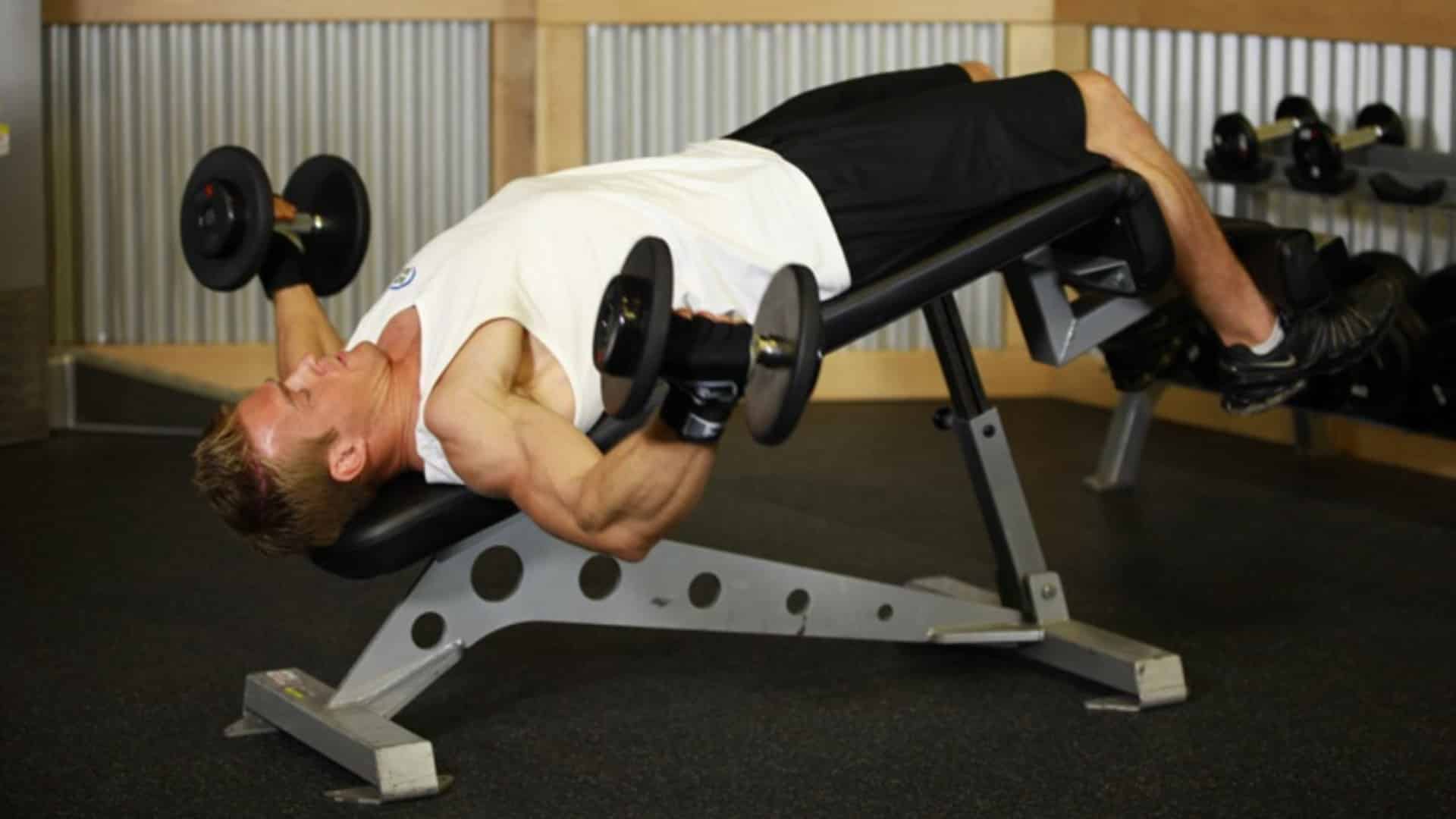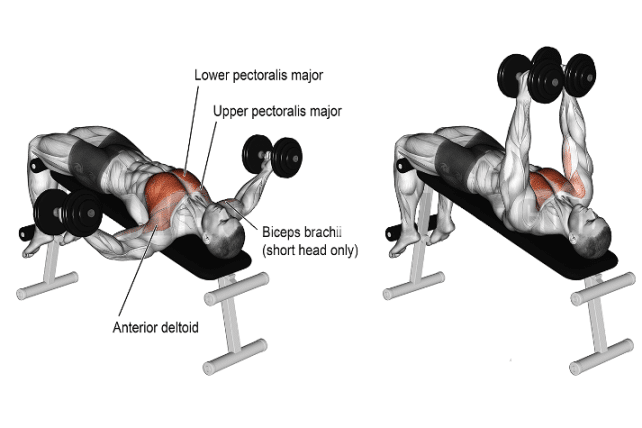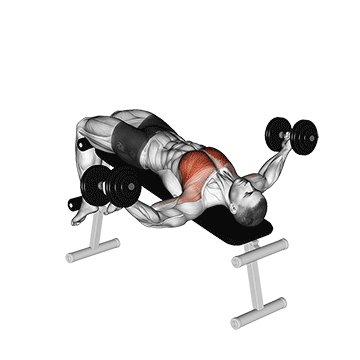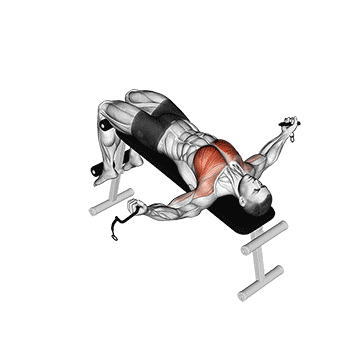If you want to add some variety to your chest workout, you should incorporate a decline fly in your chest workout routine.
This powerful exercise specifically targets your lower pectoral muscles.
Do you KNOW?
The lower chest is one of the harder areas to train because of the lack of variations available and the limited range of motion.
That’s why it’s so important to incorporate these best dumbbell decline fly exercises into your chest workout routine.
In this blog, we’ll take a deep dive into the following topic:
- What is decline dumbbell fly
- Muscles Worked
- The benefit of doing it
- How to perform a decline fly with proper form and technique
- Best Variations

- What Are Decline Chest Fly
- Muscles Worked During Decline Fly
- How To Do Decline Dumbbell Fly
- Tips and Techniques
- Decline Chest Fly Variations
- 1. One Arm Dumbbell Decline Fly
- 2. Dumbbell Decline Twist Fly
- 3. Decline Cable Fly
- How To Add Decline Chest Fly In Your Workout Routine
- 1. Sets And Reps
- 2. Frequency
- 3. Combining With Other Chest Exercises
- 4. Used As A Finisher
- Benefits of Decline Dumbbell Fly
- Best Alternatives of Declined Dumbbell Fly
- Frequently Asked Question
- Is the decline chest fly suitable for beginners?
- How to do a decline dumbbell fly without a bench?
- Is decline dumbbell fly good?
- What does decline cable flys work?
- What type of flys work lower chest?
- Does chest fly work lower chest?
- Takeaway
What Are Decline Chest Fly
Decline chest fly exercises are variations of the traditional chest fly that is performed on a decline bench. The decline bench is set at a downward slope of around 30 to 45 degrees.
It hits your chest muscles, particularly emphasizing the lower portion of your pectorals. This helps build a well-rounded, sculpted chest.
There are several variations of the decline chest fly that you can do to target different areas of your chest muscles.
The two most common types are:
- Decline Dumbbell Fly
- Decline Cable Fly
- Single-Arm Decline Dumbbell Chest Fly
- Decline Chest Fly with a Twist
- Decline Neutral Grip Dumbbell Chest Fly
Experiment with different variations to keep your workouts challenging and effective, and determine what works best for you.

Muscles Worked During Decline Fly
A decline dumbbell fly works primarily on the lower pectoral muscle of your chest.
In addition to its target, the main pec muscle. The dumbbell decline fly has the involvement of several synergist muscles, these muscles include,
- Rhomboids,
- Levator scapulae,
- Anterior deltoids, and
- Latissimus dorsi
- Serratus anterior
A handful of other muscles worked or play the role of stabilizer muscles, including your
- Biceps brachii,
- Brachialis,
- Triceps brachii,
- Wrist flexors,
- Obliques, and
- Rectus abdominis.

How To Do Decline Dumbbell Fly
- Set a decline bench at a 30-45-degree angle.
- Lie on the bench with your head at the lower end.
- Hook your feet into the footpad or roller.
- Grab a dumbbell in each hand and lie on your back on a decline bench.
- Extend the dumbbells above your chest.
- Turn the palms to face each other and the dumbbells directly over your upper chest.
- Slowly lower the dumbbells down in a wide arc, keeping your elbows slightly bent until your arms are parallel to the floor.
- Pause briefly, then bring the dumbbells back up to the starting position.
- Do 8–12 reps and 3–4 sets.

Tips and Techniques
- Start with a light set of dumbbells if you’re a beginner, and slowly increase the amount of weight each week as you build strength.
- Don’t let the dumbbells touch as they meet at the top, holding for a second in the contracted position.
- Make sure you keep your elbows bent. You should never fully straighten your arms or lock them out, as this forces the weight you’re lifting onto the elbows and shoulder joints, which increases your chance of injury.
- Don’t let your elbows drop too far when you’re in the start position. They should remain in line with your torso while lying on the bench.
- Maintain control with a 4-second descent, slight pause, and contract with a reverse motion, hold, and repeat.
- Pick a weight that you can control, that’s not too light or too heavy — find what’s right for you.
- Exhale as you lower the dumbbells, and inhale as you bring them back up.
- Use different variations of the Decline Dumbbell Fly to add variety to your workout routine.
- Take a 60-90 second rest between sets to allow your muscles to recover.
Know More: 10 Best Chest Workout With Dumbbells
Decline Chest Fly Variations
There are several variations of the decline dumbbell fly that you can try to add variety and challenge to your workout routine.
Variations include:
- Single-arm decline dumbbell chest fly,
- The declined chest fly with a twist
- Decline dumbbell chest fly with a neutral grip,
It can help keep your workouts interesting and challenging while providing a full range of motion for your chest muscles.
Here are the best decline dumbbell chest fly exercise variations for building bigger and wider chests.
1. One Arm Dumbbell Decline Fly
The single-arm dumbbell decline fly is a unilateral variation of the decline dumbbell chest fly used to target the chest muscles.
It is used by those who want to focus on one side of their chest, working at a time.
When you do a one-arm dumbbell fly, starting with the weaker side of your chest is important.

How To Do It
- Grab a dumbbell in one hand and lie on your back on a decline bench.
- Hook your feet into the foot pad or roller.
- Extend the dumbbell above your chest.
- Slowly lower your arm to your side until your wrist reaches about shoulder level or slightly above.
- Bring your arm back toward the midline of your body.
Tips
- Keep the movement slow and controlled.
- Always keep a slight bend in the elbows and never lower the weight to the point where you get any pain and pressure at the front of the shoulder joint.
2. Dumbbell Decline Twist Fly
The decline dumbbell twist fly is a slight variation of the decline dumbbell fly.
The movement targets the muscles of the chest, emphasizing the lower pecs. It also indirectly targets the muscles of the shoulder and triceps.
The slight added twist, the decline dumbbell twist fly, results in a greater chest contraction.

How To Do It
- Grab a dumbbell in each hand in each hand with a neutral grip and lie on a decline bench.
- Hold the weights above you at shoulder height.
- Slightly retract your shoulder blades, unlock your elbows, and slowly lower the dumbbells laterally.
- Once the dumbbells reach chest level, reverse the movement.
- As the dumbbells return to the starting position, twist the handles so that the bottom of the dumbbells almost touch.
- Start the next repetition without allowing the dumbbells to touch by untwisting the handles back to a neutral position.
Tips
- Imagine you’re trying to hug a tree while completing the exercise.
- Avoid touching or banging the dumbbells together at the top of each repetition to keep constant tension.
3. Decline Cable Fly
Decline Cable fly is one of the most suitable exercises for isolating the chest muscles.
Performing this exercise with cables instead of dumbbells allows for constant tension, which helps build lower Chest fibers.

How To Do It
- Set a Decline bench at a 30-degree angle. Lie on the bench with your feet flat on the foot pad or the roller.
- Lift your arms straight up from your shoulders and hold the cable handle directly over your chest.
- Slowly lower your arms to your sides until your wrists reach about shoulder level or slightly above.
- Bring your arms back toward the midline of your body, focusing on using your lower pec muscles to draw them back together.
Tips
- Remember to keep your shoulder blades pressed against the bench throughout the exercise.
- Hold and contract the chest muscles when hands are together.
- Set the bench at about 30 degrees decline.
- Maintain control with a 4-second descent, slight pause, and contract with a reverse motion, hold, and repeat.
How To Add Decline Chest Fly In Your Workout Routine
If you want to incorporate decline chest fly into your workout routine, here are some tips to help you get started.
1. Sets And Reps
| Category | Sets | Reps | Rest |
|---|---|---|---|
| Beginners | ~10 sets per week | 3 sets of 8–12 reps | 1–2 min between sets |
| Intermediate | ~15 sets per week | 3-4 sets of 8–12 reps | 1–2 min between sets |
| Advanced | ~20 sets per week | Varies based on goals | 1 min between sets |
2. Frequency
It can be performed 1–2 times weekly, depending on your overall workout schedule and goals.
3. Combining With Other Chest Exercises
Combined decline fly with other chest exercises, like bench press, push-ups, to make a good chest workout.
When combining exercises, be sure to vary the angles and resistance to target the chest muscles in different ways.
4. Used As A Finisher
Decline chest fly variations can be used as a finishing exercise at the end of your chest workout.
This helps to exhaust your chest muscles and increase blood flow, leading to greater muscle growth and definition.
Benefits of Decline Dumbbell Fly
- Unlike other chest exercises, this exercise more effectively targets the lower chest muscles.
- This helps increase muscle mass, strength, and definition in the chest.
- It also engages the front deltoids and triceps as synergists
- Compared to other chest exercises, it provides a greater range of motion.
- The workout can be performed with various weights and variations to add diversity to your chest workout routine.
- The dumbbell fly doesn’t require much equipment to perform. If you don’t have a bench, you can do dumbbell flies while lying on the floor.
Best Alternatives of Declined Dumbbell Fly
- Decline Dumbbell Bench Press
- Cable Chest Fly
- Incline Push Ups
- Close Grip Medicine Ball Push-Up
- Chest Dip
- High Cable Fly (High To Low Cable Fly)
- Dumbbell Pullover
Frequently Asked Question
Is the decline chest fly suitable for beginners?
Yes, beginners can perform the decline chest fly exercise. Start with lighter weights and focus on maintaining proper form.
How to do a decline dumbbell fly without a bench?
A decline dumbbell fly can be performed without a bench by lying on the floor with your feet elevated on a stable platform.
Decline dumbbell floor fly variation is more challenging because you must maintain proper form and balance.
Is decline dumbbell fly good?
The decline dumbbell chest fly is a good and effective exercise. It mainly builds chest muscle and strength. The decline fly helps build bigger lifts, like the barbell bench press.
What does decline cable flys work?
A decline dumbbell fly works primarily on the lower pec muscle of your chest and the front of your shoulders.
What type of flys work lower chest?
Here are the best variations of the decline chest fly exercise focusing on the lower chest.
- Decline Cable Fly
- Decline Dumbbell Fly,
- High Cable Fly (High To Low Cable Fly).
Does chest fly work lower chest?
Yes, you could try the cable chest fly, the decline dumbbell chest fly, or the high cable chest fly. These are all great exercises for the lower chest.
Takeaway
The Decline dumbbell fly is an effective exercise for targeting the lower chest muscles. Proper form is essential for maximum safety and maximum benefits.
Decline fly is recommended for anyone who wants to build body strength and gain muscle on the lower chest.
Let us know your favorite exercise in the comment section below!
Thanks for reading.

Manish brings over 10 years of hands-on experience in weight lifting and fat loss to fitness coaching. He specializes in gym-based training and has a lot of knowledge about exercise, lifting technique, biomechanics, and more.
Through “Fit Life Regime,” he generously shares the insights he’s gained over a decade in the field. His goal is to equip others with the knowledge to start their own fitness journey.
